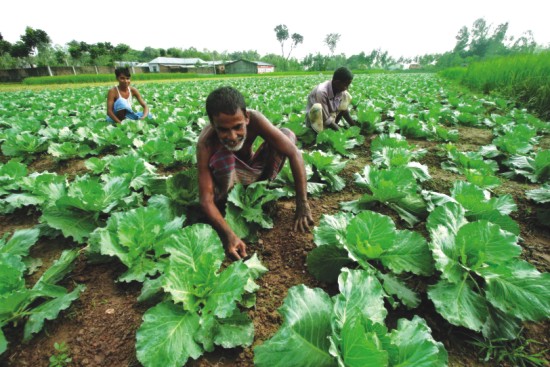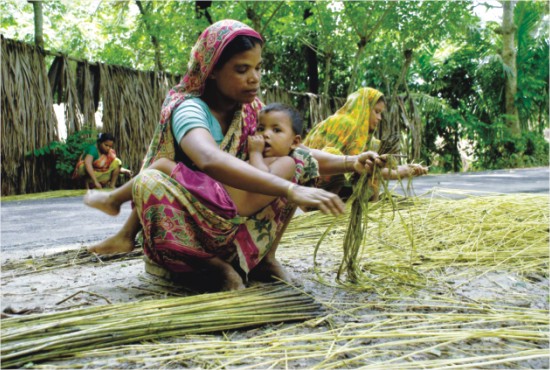
Inside
Original Forum Editorial |
| You are What You Study--Ahmed A. Azad |
| Back to the Drawing Board-Abdus Sattar Molla |
| Going Digital-- Swapan Kumar Gayen |
Treat the Water Right-- Mubarak Ahmed Khan
|
| Photo Feature: Mughli-The Lonely Mother--Altaf Qadri |
| Microcredit 2.0--Mridul Chowdhury and Jyoti Rahman |
| Miskins, Misfits and Mothers-- Farah Mehreen Ahmad |
| Growing Pains-- Mustafizur Rahman |
| Jessore Days-- Ziauddin Choudhury |
| Manslaughter-- Shamsuddin Ahmed |
Microcredit 2.0 Mridul Chowdhury and Jyoti Rahman discuss the future of microcredit Microcredit hardly needs an introduction. From its inception about three decades ago, it has attracted billions of dollars of funding reaching millions of customers, garnering a Nobel Peace Prize and the highest civilian award of the United States for its most visible proponent, Prof. Muhammad Yunus. It has turned around the misconception that poor people are not bankable. The breaking of this myth has had a revolutionary impact on the development discourse, spurring a whole new dimension of development activity that did not exist before. Microcredit has also had a notable impact in giving development practitioners new means for providing support to poor women. It cannot be denied that there are possibly very few who have had more global impact on the practice of development than Prof. Yunus. However, in the euphoria surrounding microcredit, we often tend to ignore its limitations in offering a comprehensive and sustainable solution to the complex and dynamic problems of poverty. By emphasising the individual borrower's responsibility to repay the loan, and by encouraging them to build businesses, increase incomes and exit poverty, microcredit avoids the multi-generational poverty traps that bedevil the welfare dependants in the rich world. According to Prof. Yunus, "5 per cent of the Grameen borrowers get out of poverty every year." And yet, it turns out, we don't actually know much about how microcredit has impacted on people's lives when it comes to statistical evidence. Microcredit and poverty reduction Could it not be the case that those who tend to be relatively healthy -- perhaps because they are not malnourished, that is, not the poorest in the village -- are the ones who actually borrow?
Or, perhaps it is something else that drives both the borrowing and the better health -- perhaps those who borrow have some prior education (formal or otherwise) that make them more entrepreneurial and health conscious simultaneously? Economists have devised statistical techniques to get around this kind of "chicken or egg" problem (endogeneity, in technical parlance). David Roodman of the Centre for Global Development and Jonathan Morduch of New York University replicated some earlier works on the impact of microcredit in Bangladesh using such techniques. One of the studies replicated is a 1998 classic that found that for every 100 taka lent to a woman, her family's annual consumption increased by 18 taka. Extrapolation from this finding forms the basis of the claim that 5 percent of the borrowers exiting poverty per year. Another exercise, also replicated, found that microcredit reduced consumption volatility among the recipients -- that is, it helped the recipients survive bad times such as the aftermath of a flood. Surprisingly, the authors find that there is little statistical evidence to support any of the earlier findings. They do not conclude that microcredit is harmful. Rather, they argue that the econometric strategies adopted in those earlier works to untangle the cause and effect relationship between credit and consumption is at fault. Using a path-breaking statistical methodology called "randomised evaluation," Abhijit Banerjee, Esther Duflo, Rachel Glennerster and Cynthia Kinnan of MIT randomly chose 52 slums in the Indian city of Hyderabad where a microfinance provider was asked to provide microcredit. For comparative purposes, another 52 slums were chosen with very similar demographics and other characteristics where no microcredit was provided. This kind of comparative evaluation is increasingly accepted as one of the most unbiased methodologies for evaluating impact of a particular development intervention. Dean Karlan of Yale University and Jonathan Zinman of Dartmouth College carried out another "randomised evaluation" at the level of the individual borrower in the Philippines. What do these papers find? Limitations of microcredit Limited effect on aggregate economic growth: In Bangladesh, the birthplace of the modern version of microcredit, the phenomenon has flourished and expanded rapidly for nearly three decades. But there is still little discernible effect at a macro-economic scale -- there is little statistical evidence of its impact on per capita income, which has remained one of the lowest in the world. Activities made possible by microcredit, such as poultry raising and household manufacturing of handicrafts, have limited growth potential. Most micro-borrowers do not have the capacity of expanding operations and absorbing more than a small amount of loan. Often, the immediate welfare effect of microcredit loans is not sustained for long due to mitigating factors such as rapid growth in the family size, poor harvests, and natural disasters. Further, microcredit loans are mostly catered towards self-employment, which does not create jobs for others, thereby further limiting the economic effect at a broad level. Limited ability to reach the poorest: It is also generally accepted that microcredit largely fails to reach the hard-core poor of the society -- it is generally the "middle and upper-income poor" who have benefited. The poorest of the poor are often left out, partly because they are often homeless and mobile -- during times of natural disaster or lean seasons (monga), large-scale temporary migration occurs in certain poor regions of the country. Plus, even if the ultra-poor are lent some funds, they are often forced to spend much of the loan on basic necessities such as food and housing rather than on income-generating activities. Tackles only one piece of the poverty puzzle: The causes of poverty are complex and dynamic, and lack of access to capital is only one aspect of poverty. With the over-emphasis of microcredit on only one piece of the poverty puzzle, there is danger of simplifying a problem that needs multi-dimensional approach for a solution. The fact that microcredit has relatively little effect on the production side of the national economy is perhaps a curb on its ability to bring about visible positive contribution to economic growth.
New policy agenda for microcredit This means that even if microcredit has no discernible impact on poverty in the short run, there may well be some effects over a longer time-frame if these businesses prosper. This longer term effect can be magnified if such businesses are lent even larger sums so that they can expand and employ more people or adapt better technology. Dubbing it a "partial marvel," The Economist sums up microcredit's benefit thus: "By being willing to take a risk on entrepreneurial sorts who lack any other way to start a business, microcredit may help reduce poverty in the long run, even if its short-run effects are negligible." Can microcredit do better than being a signaling device? How can this be done? We suggest three steps.
Second, microcredit should focus on related human capacity development in addition to access to capital -- targeted training programs can be a prerequisite to become eligible for certain kinds and amounts of loans. Although some microcredit programs have such initiatives in a limited scale, the big players such as Grameen Bank do not and the Grameen approach is generally the one taken by most microcredit organisations across the world. The notion of Prof. Yunus that "everyone is a born entrepreneur and knows how best to utilize money" is hard to support. It is a well-understood fact that people need skills, access to market and other support structures to make good use of money. Ignoring those factors leave the power of microcredit under-utilised in many ways. Third, microcredit should be explicitly linked with other sources of small loans that help more successful borrowers expand their business. Currently, some microcredit providers do have such schemes in limited scale, but these are not sufficient. Other banks and similar financiers should come forward to fill up the gap of the small and medium sized "missing middle" -- those whose operations are too big for the support of microcredit organisations and too small for the support of commercial banks. Current efforts by SME-focused banks such as BRAC Bank and the government-controlled SME Foundation hardly focus on the micro-enterprises that employ 1-9 people. This is a sector that makes up a significant portion of Bangladesh's economy and represents a huge untapped potential that neither microfinance institutions nor SME-focused entities address adequately. The road ahead
emphasis and resource allocation. Other poverty alleviation tools such as building up of rural infrastructure, human capacity building, micro-enterprise development, health and demographic planning should be given adequate priority in order to create an environment where access to financial capital can add much more value than it is currently able to. It is clear that, for microcredit to be an effective tool for poverty reduction, it needs to evolve to a new level with new inter-linkages, based on the lessons learnt during the first three decades of its operation. It also needs to be better integrated into a broader agenda for poverty alleviation and economic growth, since by itself, it is not as powerful a tool as some claim it to be. But ironically, the success of the first wave of microcredit seems to be impeding its own evolution to an improved, broader, and more integrated instrument for change. It is a crucial responsibility of the policy-makers from different quarters to realise the limitations of microcredit in its current form and approach and act accordingly for the very purpose of harnessing the power of microcredit to its fullest. Institutionalised microcredit is beginning its fourth decade. For Prof. Yunus's dream of consigning poverty to museums to come true, it is clear that microcredit as it is currently practiced has to evolve and become better integrated with other development instruments and financial interventions. We hope that Prof. Yunus himself takes a lead in taking microcredit to the next level -- it will not undermine the concept of microcredit that he painstakingly developed into the giant global program that it is today, but it will help the world to critically look at the gaps that microcredit leaves behind and encourages linkages that address those gaps. Let the coming decade be the time when microcredit really lives up to its promise.
1. Interview in 2007 on the PBS show "NOW." Available at: www.pbs. org/now/enterprisingideas/Muhammad-Yunus.html. Mridul Chowdhury is the CEO of a global telemedicine company and co-founder of Jagoree. Jyoti Rahman is an applied macroeconomist and a blogger. They can be reached at dpwriters@ drishtipat.org.
|



